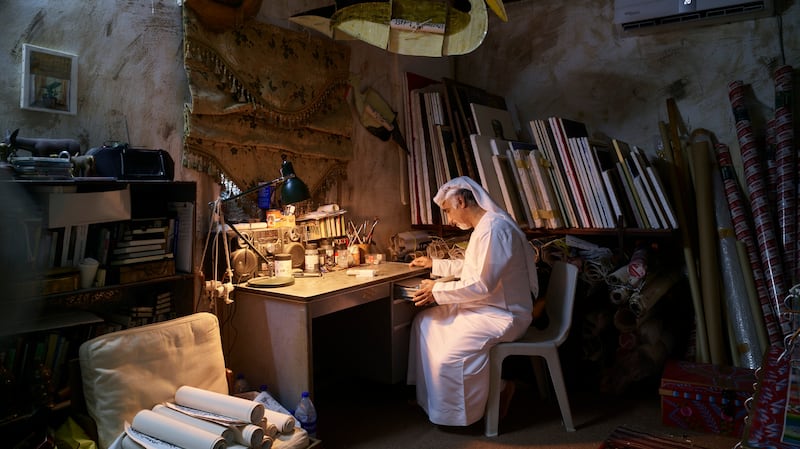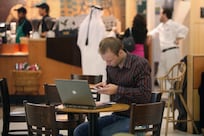The physical works within Abdullah Al Saadi’s ouevre are only a fragment of his art.
They can be seen as mere vestiges of an engrossing artistic process involving solitary excursions to the UAE countryside as well as a meticulous archiving practice. What comes before, during and after the creation of each piece is integral to the object in itself.
This is what Tarek Abou El Fetouh, curator of this year’s National Pavilion UAE, wants to highlight at the Venice Art Biennale.
The exhibition – Abdullah Al Saadi: Sites of Memory, Sites of Amnesia – will be running from Saturday until November 24. It will bring together eight bodies of Al Saadi’s works, two of which were created specifically for the biennial.
But it is how these works are curated, and how they are presented to the pavilion’s visitors, that unpacks the significance of the Emirati artist’s process as well as his importance to the local artistic landscape.

Al Saadi is a forerunner of the local art scene. He is considered one of the key figures in the development of contemporary art in the UAE, having been actively creating works since the 1980s. His practice involves painting, drawing, sculpting and photography as well as collecting and cataloguing found objects and the creation of new alphabets.
Abou El Fetouh previously worked with Al Saadi for his Expo 2020 Dubai commission Terhal. The work consists of boulders on which maps – or rather artistic reflections – of Fujairah’s Wadi Tayybah have been painted. The pieces are a permanent installation in an outdoor seating area at the Expo site.
Abou El Fetouh had known Al Saadi for years before curating Terhal, but the work gave him a sharp insight into the artist’s practice. “He took me in his car and drove into Wadi Tayybah,” he said. “I actually saw that there’s quite a lot of thought behind the selection of the rocks.”
For Terhal, Al Saadi ventured out alone into Wadi Tayybah, camping there until he felt attuned to the landscape. He brought a poem with him, which he read and reflected on amid the jagged, green landscape of the surrounding mountains. It was only then that he began to select the stones that would form the project.
Terhal, of course, is a single body of work – and it gives just a sliver of an insight into Al Saadi’s artistic methodology. With Sites of Memory, Sites of Amnesia, Abou El Fetouh found he had a lot more room to explore the rituals surrounding Al Saadi’s art – as well as a greater breadth of work to showcase.

The exhibition will explore several series of works that Al Saadi has created in the last decade. These include The Purl and Silk Journey, which presents long vertical scrolls that the artist produced in 2015 during two excursions to the eastern part of the UAE, not far from his hometown of Khor Fakkan. For the first part of the work, The Purl Journey, the artist meditated on the mountainous landscape of Wadi Madha by drawing and writing on long scrolls. He stood over verdant valleys, contemplating concepts of nourishment and vitality while, over the course of five days, he lived on a diet of flatbread, tea and coffee. The Silk Journey, meanwhile, comes as a result of a bicycle trip the artist took across Madha, Khor Fakkan, Dibba and Wadi Bih.
Al Zannoba Journey, on the other hand, involved another more grounded mode of travel. The artist set out on a walk wearing zannoba, or slippers the artist made from goat skin and rubber. As he walked, he pushed a wheelbarrow that carried his supplies. His slippers unravelled and his wheelbarrow, too, gave way. Each hurdle prompted novel considerations and reflections. Al Saadi captured these elements through traditional paintings as well as footage from a GoPro camera he attached to the wheelbarrow. He also kept a journal and painted his journey on stones gathered during the passage.
However, the stones, paintings and scrolls can only tell so much, and Abou El Fetouh wanted to capture the more ineffable dimensions of Al Saadi’s practice.
“Once we started to work on the pavilion, this was my first obsession,” Abou El Fetouh said.

The exhibition space itself is a starting point. It has been designed to reflect upon the swerving routes Al Saadi takes during his excursions – on which he ponders as he paints on stones or renders his asemic letters. Steel shelves curving through the space will display the confectionery boxes that Al Saadi uses to contain his works.
Similarly, the artworks stored in boxes and metal chests allude to the artist’s studio space in Khor Fakkan, as well as his “meticulous cataloguing approach”, where everything is precisely dated and filed – a decades-long effort that Abou El Fetouh says made it easy to sift through what is otherwise a monumental body of work.
Within the exhibition, the displayed works have also been arranged with an aesthetic consideration. The show will begin with pieces that have a more restrained colour palette – almost monochromatic – gradually becoming more vibrant as visitors tread deeper into the exhibition and towards the performance space.

Storytelling and performances are the keys to unravelling Al Saadi’s methodology. Professional actors as well as interns will be animating the pavilion in Venice, going through artworks stored in chests, they will be touching upon Al Saadi’s cataloguing approach. Opening the confectionery boxes and metal chests, actors will unroll scrolls and elaborate on artworks. Performers will enact facets of the artist’s process as they unpack any given work, “telling you the story of this journey.”
They will read poems that Al Saadi recites during his excursions. They will talk about the animals that sometimes accompany him. They will discuss how he reflects on landscapes, painting them not with cartographic accuracy but rather with impressionistic flair. And perhaps most insightfully of all, they will recite literature that in some way relays the poetics of his craft – including the works of the sixth century pre-Islamic Arabian poet Imru al-Qais.
As much as Al Saadi is an artist with a uniquely idiosyncratic approach, he also sustains a legacy rooted in Arabian poetry that involves engaging with the natural environment.
“This artistic relationship with nature is something that has existed in the region for centuries,” Abou El Fetouh says. “From the pre-Islamic poets to the time of Abassids and even after. It emerges in a contemporary framework within the works of Abdullah. The performances aim to highlight this, going “more in depth about the connection between the journeys and the tradition of the Arab poets.”
This artistic dialogue with nature somewhat extends to the two new works. However, they are much more involved with the exhibition’s title – Sites of Memory, Sites of Amnesia – and relate to the act of remembrance, which effaces as much as it evokes.

This tide of images and thought are encapsulated poignantly within contraptions that unfurl a scroll, allowing viewers to see only part of the work at the time. Maps and writing are revealed, as are symbolic notations, which then move aside as new ones come into view.
Even though the artworks in Sites of Memory, Sites of Amnesia are deeply rooted within poetic specificities, locations and experiences, as a whole the exhibition is set to confront universal themes that, Abou El Fetouh says, will hopefully resonate with an audience that may just be discovering Al Saadi’s works.
“When you talk to people about memory, and collective memory, they immediately start to reflect on where they’re from and what they consider their own sites of memory and amnesia,” Abou El Fetouh says.







